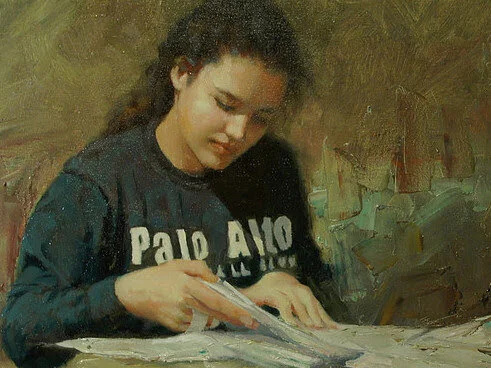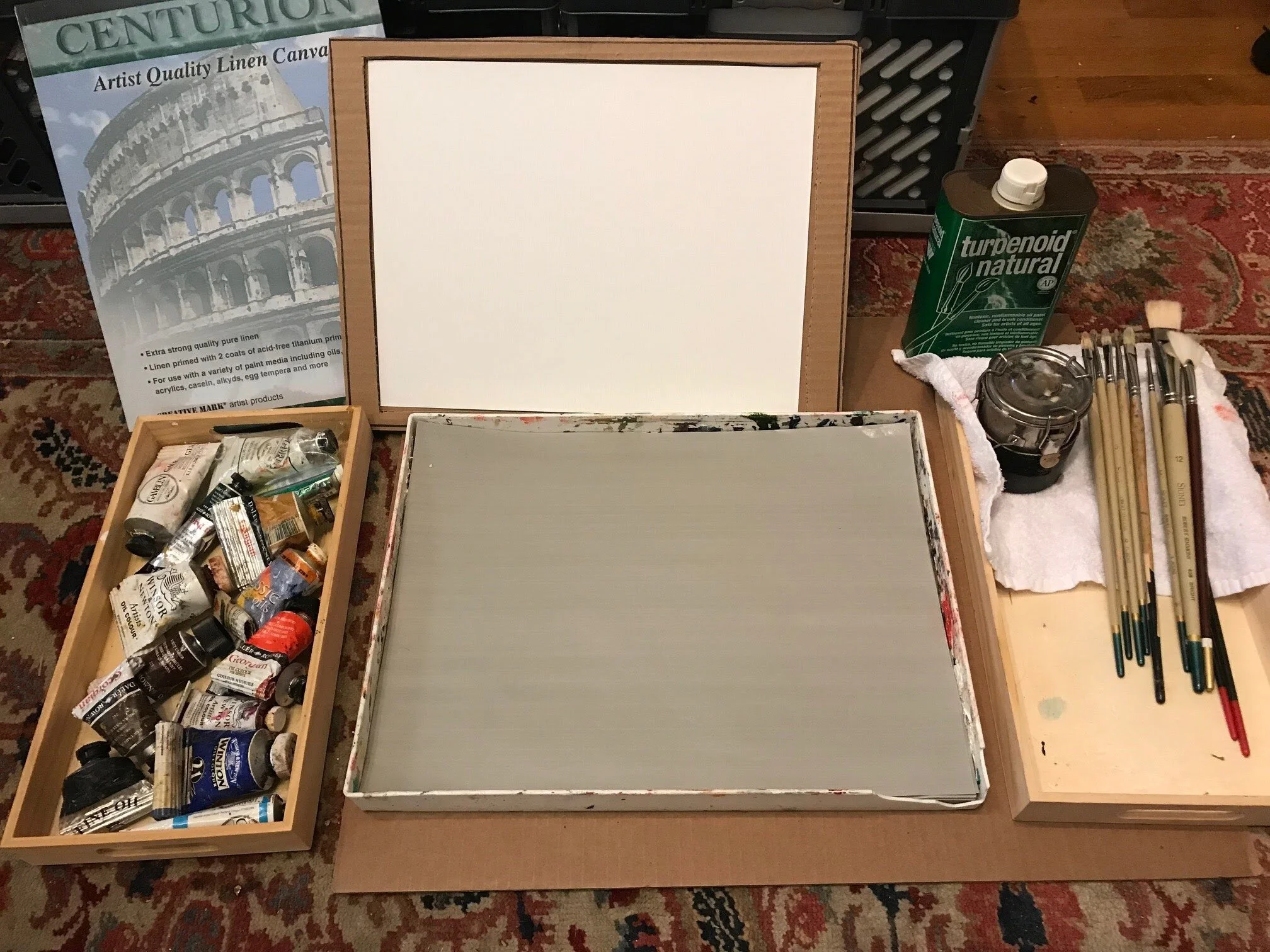Portrait Painting - Materials and Syllabus
Taught by: Darren Kerr - dkerr@dkerr.net 650-814-2180
Pacific Art League
When: Wednesdays 1-3:30pm, Sep 22 to Nov 10 2021
Where: outdoors under canopy, 853 Forest Avenue, Palo Alto 94301
Reference Materials at:
Google Drive: https://drive.google.com/drive/folders/1Az6XlbSAu9ofAcpz5mrpDBjrfXbqjaIz?usp=sharing
Synopsis: Applying an academic approach, students will draw and paint representational portraits using models and photo references.
Topics covered will include materials, paint application, facial anatomy and proportions, color theory and color matching, tone and edge control, choosing interesting poses and compositions, and developing our unique style.
Typically we will work on each painting for two weeks. The first week with a new model, we will draw or paint to capture an accurate likeness and strong value statement. The second week we will make some corrections and then focus on color and edges. Students may also have the opportunity to continue working on their paintings and getting feedback using photo reference.
The class will take place outdoors under a canopy and/or umbrellas.
Tables, chairs, and easels will be provided.
Materials
Canvas/Support
Four canvases 12x16 or larger.
Brushes - Use whatever you are comfortable with. For class studies, I usually will have:
1 or 2 small (#1 or #2) filbert or round bristle for initial drawing
1 large (#12 to #16) flat or filbert bristles for background and toning canvas
1 med/large (#10 to #12) flat bristle for large objects or cutting around object
3 - 5 assorted (#4 to #8) filbert bristles (1 per major tone/hue)
2 small (#2 - #4) long flat sable or soft synthetic filbert or round for fine details
1-2 medium (#4 - #8) long flat or filbert sable or synthetic for blending edges
Oil Paint (can use Acrylic if you prefer, but Darren will demonstrate using Oil)
Titanium White (large tube)
Yellow Ochre and Cad Yellow or Hansa Yellow
Transparent Red Oxide (or Orange Oxide or Earth Oxide or Burnt Umber)
Burnt Sienna
Alizarin Crimson
Cadmium Red Hue
Ultramarine Blue
Olive Green (or terre verte, or sap green)
Raw Umber - for underpainting and mixing grays (large tube)
Ivory Black
Miscellaneous:
Palette knife - long & thin is best for all purpose mixing
Paper towels for wiping down brushes, plus scrap terry cloth towels
Palette (12x16” Gray Matters or Timbr pad in Masterson box, or wood or glass)
Turpenoid or Gamsol in brush cleaning jar (if glass, wrap bottom in duct tape)
Shallow box with towel/rags to place turp jar and wet brushes while painting
Sketchbook, pencil, charcoal pencils for block-in
Prospek or Derwent proportional divider or ruler
Option to Purchase or Borrow from Instructor
Please let me know (dkerr@dkerr.net) if you would like to borrow or purchase any/all materials and are able to pick up in Palo Alto.
New Tools and Topics this Year:
Breaking down facial features into basic forms, drawing from imagination
Detailed practice painting facial features
Accurate measuring from photos using PixelStick app
Photo handouts of skin tones for help mixing paint
Male/Female face and figure academic proportions and common variations
Options to purchase supplies from instructor at cost:
Prospek proportional divider and view finder
Palette box
Stretched linen, wood support, linen panels, linen sheets
Tricks for saving paint and cleaning brushes
Lighting the model to advance the form
Changing what you see to make a better painting
Reviewed Topics:
Using Photoshop posterization and color maps to help isolate and simplify color fields
Using mColorMeter app to identify exact reproducible color from photo
Toning canvas and starting painting
Materials
Notes on Painting Surface
TYPES OF CANVASES AND PAINTING SUPPORTS
The traditional support (painting surface) for portraits has ranged from stretched linen, stretched canvas, and wooden panel at the high end, down to cardboard or primed paper at the less expensive end of the spectrum. For a commissioned piece, you would normally want to use a good stretched linen canvas on gallery mount (1 ½” +) stretchers.
However, for a class setting, you can get the same feel by purchasing a pad of decent linen sheets for a small fraction of the cost of stretched linen. Another advantage of linen sheets is that your finished paintings can be stored very compactly - I save studies in a binder for later reference. My preference is Centurion brand acrylic primed linen pads, which cost around $2 to $6 a sheet, depending on the size and supplier. I usually order from Jerry’s Artarama in bulk, though it takes a couple weeks to deliver.
Now make a few cardboard backings for the canvas/linen sheets to work on while painting. The quick way is just glue the canvas to a larger sheet of cardboard, so it’s easy to handle (you will get less paint on your clothes and car while traveling back from class).
I go a step further and also glue an additional piece of cardboard cut into a frame shape around the canvas. This allows me to safely stack several wet paintings when traveling - I can even put into a backpack with my other painting gear without ruining my wet painting.
Priming and/or Toning the canvas
If I have time, I like to have a toned and textured surface on the canvas.
This provides a few benefits:
A random brush texture will give the whole painting a “painterly” look even in the portions of the portrait or background that are thinly applied or even unpainting.
If some of the canvas is unpainting in portions, the under-tone may provide a uniformity that binds all the colors that you paint together
A medium valued light tone is good for portraits (somewhere around a 7 on the 10-point value scale - which means it’s around 70% lighter than black and 30% darker than white).
A neutral warm gray color is the easiest color to start a realistically colored portrait. If you have raw umber and white acrylic, mix and apply with a large brush in random directions. The tone (aka value or “lightness”) should be slightly lighter than the gray of a Gray Matters palette pad, which is available at University Art on online from Blick, Utrecht, or Jerry’s Artarama.


